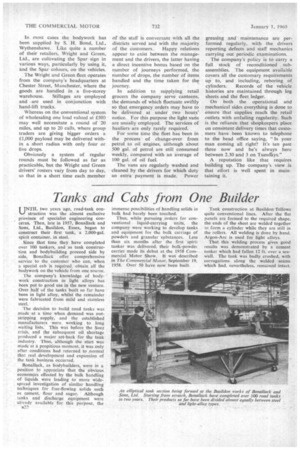Tanks and Cabs from One Builder
Page 56

If you've noticed an error in this article please click here to report it so we can fix it.
UNTIL two years ago, road-tank con1/4.1 struction was the almost exclusive , province of specialist engineering concerns. Then, late in 1957, Bonallack and Sons, Ltd., Basildon, Essex, began to construct their first tank, ' a 2,000-gal. spirit container, in steel.
Since that time they have completed over 100 tankers, and as tank construction and bodybuilding proceed side by side, Bonallack offer comprehensive service to the customer who can, when a special cab is required, obtain all the bodywork on the vehicle from one source.
The company's knowledge of bodywork construction in light alloys has been put to good use in the new venture. Over half of the tanks built so far have been in light alloy, whilst the remainder were fabricated from mild and stainless steel.
The decisilan to build road tanks was made at a time when demand was outstripping supply, and the established manufacturers were working to long waiting lists. This was before the Suez crisis, and the subsequent oil shortage produced a major set-back for the tank industry. Thus, although the start was made-at a propitious moment, it was only after conditions had returned to .normal that real development and expansion of the tank business occurred.
Bonallack, as bodybuilders, were in a position to appreciate that the obvious economies effected by the bulk handling of liquids were leading to more Widespread investigation of similar handling techniques for free-flowing solids such as cement, flour and sugar. Although tanks and discharge equipment were already available for this purpose, the
B.27
immense possibilities of handling solids in bulk had barely been touched.
Thus, while pursuing .orders for conventional liquid-carrying units, the company were working to develop tanks and equipment for the bulk carriage of powders and granular -substances. Less than six months after the first spirit tanker was delivered, their bulk-powdet carrier made its debut at the 1.958 Commercial Motor Show. It was described in The Commercial Motor, September 19, 1958. Over 50 have now been built.
Tank construction at Basildon 'follows quite conventional lines. After the flat panels are formed to the required shape, the ends of the sheet are welded together to form a cylinder while they are still in the rollers. All welding is done by hand. Argon-Arc is used for light alloys.
That this welding process gives good results was demonstrated by a cement tanker which had fallen 12 ft. over a seawall. The tank was badly crushed, with corrugations along the welded seams which had, nevertheless, remained intact.




























































































